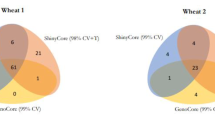Abstract
Temperature gradient capillary electrophoresis (TGCE) is a high-throughput method to detect segregating single nucleotide polymorphisms and InDel polymorphisms in genetic mapping populations. Existing software that analyzes TGCE data was, however, designed for mutation analysis rather than genetic mapping. Genetic recombinant analysis and mapping assistant (GRAMA) is a new tool that automates TGCE data analysis for the purpose of genetic mapping. Data from multiple TGCE runs are analyzed, integrated, and displayed in an intuitive visual format. GRAMA includes an algorithm to detect peaks in electropherograms and can automatically compare its peak calls with those produced by another software package. Consequently, GRAMA provides highly accurate results with a low false positive rate of 5.9% and an even lower false negative rate of 1.3%. Because of its accuracy and intuitive interface, GRAMA boosts user productivity more than twofold relative to previous manual methods of scoring TGCE data. GRAMA is written in Java and is freely available at http://www.complex.iastate.edu.


Similar content being viewed by others
References
Bailey DW (1971) Recombinant-inbred strains. An aid to finding identity, linkage, and function of histocompatibility and other genes. Transplantation 11:325–327
Bariana H, Parry N, Barclay I, Loughman R, McLean R, Shankar M, Wilson R, Willey N, Francki M (2006) Identification and characterization of stripe rust resistance gene Yr34 in common wheat. Theor Appl Genet 112(6):1143–1148
Burr B, Burr FA (1991) Recombinant inbreds for molecular mapping in maize: theoretical and practical considerations. Trends Genet 7:55–60
Curtis D, Gurling H (1993) A procedure for combining two-point lod scores into a summary multipoint map. Hum Hered 43:173–185
Hsia A-P, Wen T-J, Chen H, Liu Z, Yandeau M, Wei Y, Guo L, Schnable P (2005) Temperature gradient capillary electrophoresis (TGCE): a tool for the high throughput discovery and mapping of SNPs and IDPs. Theor Appl Genet 111(2):218–225
Lathrop GM, Lalouel JM (1984) Easy calculations of lod scores and genetic risks on small computers. Am J Hum Genet 36:460–465
Lee M, Sharopova N, Beavis WD, Grant D, Katt M, Blair D, Hallauer A (2002) Expanding the genetic map of maize with the intermated B73 × Mo17 (IBM) population. Plant Mol Biol 48:453–461
Lincoln S, Daly MJ, Lander ES (1993) Constructing genetic linkage maps with MAPMAKER/EXP version 3.0: a tutorial and reference manual. http://www.broad.mit.edu/genome_software/other/mapmaker.html
Mester DI, Ronin YI, Hu Y, Peng J, Nevo E, Korol AB (2003) Efficient multipoint mapping: making use of dominant repulsion-phase markers. Theor Appl Genet 107:1102–1112
Stam P (1993) Construction of integrated genetic linkage maps by means of a new computer package: JoinMap. Plant J 3:739–744
Sulima I, Kalendar RN, Sivolap IM (2000) The mapping of the barley genome by RAPD analysis using double haploid strains. Tsitol Genet 34(4):41–49
Acknowledgments
We thank Dr. An-Ping Hsia for providing assistance in gathering materials and resources and editing the manuscript, Hsin “Debbie” Chen for early descriptions of the functionalities needed in a software program that was to become GRAMA, and Yi-Yin “Rita” Chen for entering much of the data from which our statistics were derived. We would also like to thank Sunyoung Park for her assistance in the creation of some of the figures and the other colleagues in the ISU Complex Computation Lab for discussion. This research was funded by National Science Foundation award DBI 0321711 to P.S.S. and others.
Author information
Authors and Affiliations
Corresponding author
Additional information
Communicated by H. C. Becker
Rights and permissions
About this article
Cite this article
Maher, P.M., Chou, HH., Hahn, E. et al. GRAMA: genetic mapping analysis of temperature gradient capillary electrophoresis data. Theor Appl Genet 113, 156–162 (2006). https://doi.org/10.1007/s00122-006-0282-6
Received:
Accepted:
Published:
Issue Date:
DOI: https://doi.org/10.1007/s00122-006-0282-6




